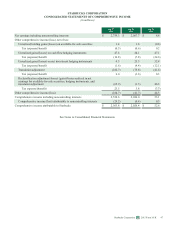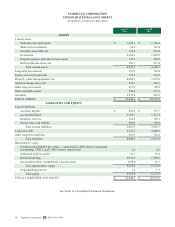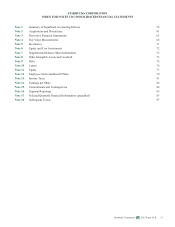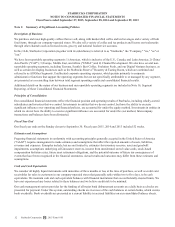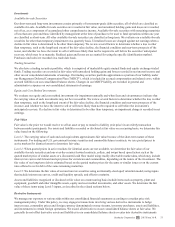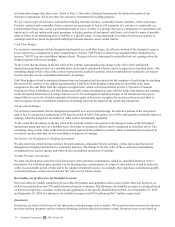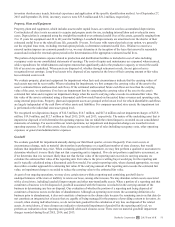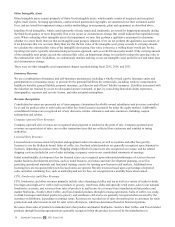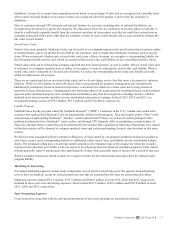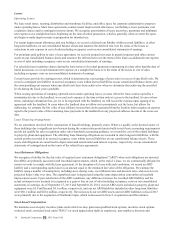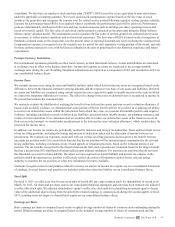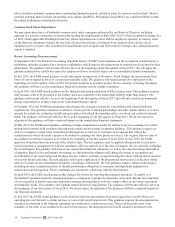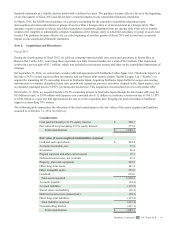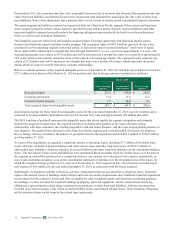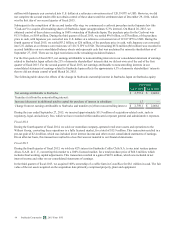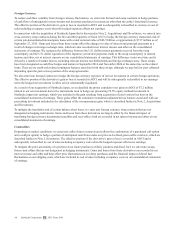Starbucks 2015 Annual Report Download - page 60
Download and view the complete annual report
Please find page 60 of the 2015 Starbucks annual report below. You can navigate through the pages in the report by either clicking on the pages listed below, or by using the keyword search tool below to find specific information within the annual report.
Other Intangible Assets
Other intangible assets consist primarily of finite-lived intangible assets, which mainly consist of acquired and reacquired
rights, trade secrets, licensing agreements, contract-based patents and copyrights, are amortized over their estimated useful
lives, and are tested for impairment using a similar methodology to our property, plant and equipment, as described above.
Indefinite-lived intangibles, which consist primarily of trade names and trademarks, are tested for impairment annually during
the third fiscal quarter, or more frequently if an event occurs or circumstances change that would indicate that impairment may
exist. When evaluating other intangible assets for impairment, we may first perform a qualitative assessment to determine
whether it is more likely than not that an intangible asset group is impaired. If we do not perform the qualitative assessment, or
if we determine that it is not more likely than not that the fair value of the intangible asset group exceeds its carrying amount,
we calculate the estimated fair value of the intangible asset group. Fair value is the price a willing buyer would pay for the
reporting unit and is typically calculated using an income approach, such as a relief-from-royalty model. If the carrying amount
of the intangible asset group exceeds the estimated fair value, an impairment charge is recorded to reduce the carrying value to
the estimated fair value. In addition, we continuously monitor and may revise our intangible asset useful lives if and when facts
and circumstances change.
There were no other intangible asset impairment charges recorded during fiscal 2015, 2014, and 2013.
Insurance Reserves
We use a combination of insurance and self-insurance mechanisms, including a wholly-owned captive insurance entity and
participation in a reinsurance treaty, to provide for the potential liabilities for certain risks, including workers’ compensation,
healthcare benefits, general liability, property insurance, and director and officers’ liability insurance. Liabilities associated with
the risks that are retained by us are not discounted and are estimated, in part, by considering historical claims experience,
demographics, exposure and severity factors, and other actuarial assumptions.
Revenue Recognition
Consolidated revenues are presented net of intercompany eliminations for wholly-owned subsidiaries and investees controlled
by us and for product sales to and royalty and other fees from licensees accounted for under the equity method. Additionally,
consolidated revenues are recognized net of any discounts, returns, allowances and sales incentives, including coupon
redemptions and rebates.
Company-operated Store Revenues
Company-operated store revenues are recognized when payment is tendered at the point of sale. Company-operated store
revenues are reported net of sales, use or other transaction taxes that are collected from customers and remitted to taxing
authorities.
Licensed Store Revenues
Licensed store revenues consist of product and equipment sales to licensees, as well as royalties and other fees paid by
licensees to use the Starbucks brand. Sales of coffee, tea, food and related products are generally recognized upon shipment to
licensees, depending on contract terms. Shipping charges billed to licensees are also recognized as revenue, and the related
shipping costs are included in cost of sales including occupancy costs on our consolidated statements of earnings.
Initial nonrefundable development fees for licensed stores are recognized upon substantial performance of services for new
market business development activities, such as initial business, real estate and store development planning, as well as
providing operational materials and functional training courses for opening new licensed retail markets. Additional store
licensing fees are recognized when new licensed stores are opened. Royalty revenues based upon a percentage of reported
sales, and other continuing fees, such as marketing and service fees, are recognized on a monthly basis when earned.
CPG, Foodservice and Other Revenues
CPG, foodservice and other revenues primarily include sales of packaged coffee and tea as well as a variety of ready-to-drink
beverages and single-serve coffee and tea products to grocery, warehouse clubs and specialty retail stores, sales to our national
foodservice accounts, and revenues from sales of products to and license fee revenues from manufacturers that produce and
market Starbucks-, Seattle’s Best Coffee- and Tazo-branded products through licensing agreements. Sales of coffee, tea, ready-
to-drink beverages and related products to grocery and warehouse club stores are generally recognized when received by the
customer or distributor, depending on contract terms. Revenues are recorded net of sales discounts given to customers for trade
promotions and other incentives and for sales return allowances, which are determined based on historical patterns.
Revenues from sales of products to manufacturers that produce and market Starbucks-, Seattle’s Best Coffee- and Tazo-branded
products through licensing agreements are generally recognized when the product is received by the manufacturer or
56 Starbucks Corporation 2015 Form 10-K



